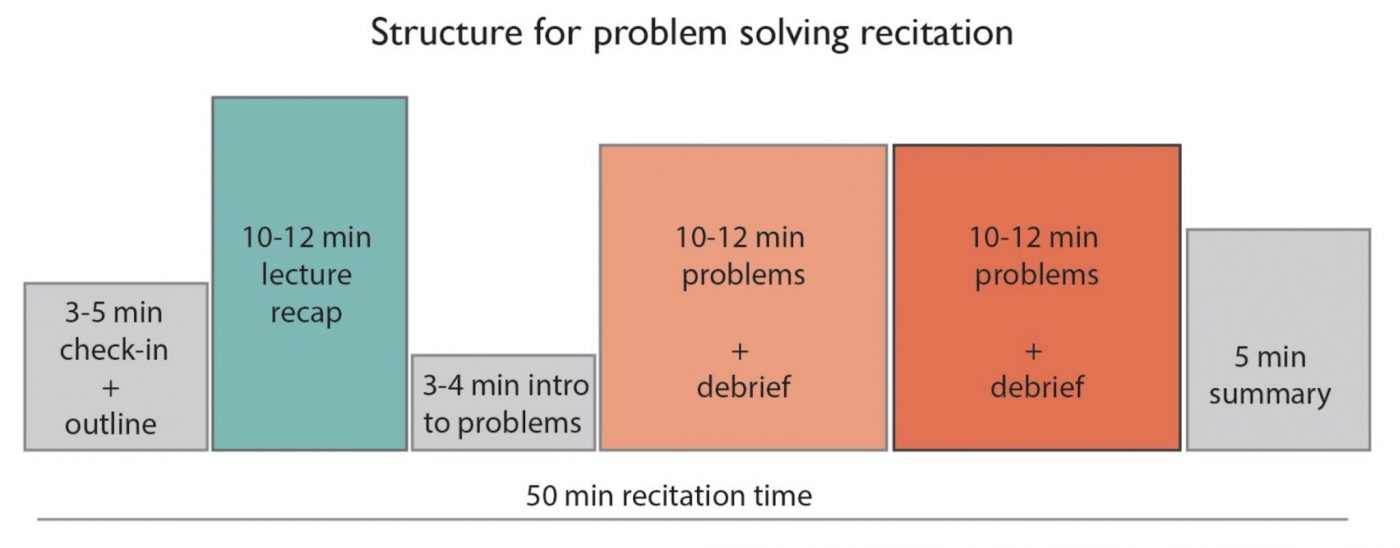Tips & Strategies for Facilitating Discussion Sections
Discussion sections are a critical part of most courses (e.g. Watt et al. 2014), where you can foster more engagement among students and between students and instructors.
- Consider providing meaningful collaborative activities during section, and motivating students to attend and engage by grading (even just for completion) the activities they engage in.
- Find ways to set up a welcoming community and guide students through clear learning outcomes – CU Boulder has a useful set of relevant tips for thoughtfully setting up Discussion Sections in large courses.
Structure discussion section to engage ALL students (rather than just the few who interact with the TA): MIT has useful Resources for TAs leading recitations, with an example of how to integrate small group problem-solving into discussion under the heading “Large-lecture classes with a focus on problem solving”
The following image is from MIT’s TA Training website (resource linked above):

Tips & Strategies for Facilitating Labs
Lab sections provide an opportunity for students to learn hands-on skills and explore scientific concepts, but many sections can feel to students like they are just following a “cookbook” of instructions; so here are some resources to support more student learning and critical thinking during lab sections.
UC Berkeley offers guidance to it’s graduate student instructors, including tips for pre-lab activities, what to do during and after the lab, and ideas for asking effective questions.
Reach out to CEILS Senior Associate Director Shanna Shaked (shaked@ceils.ucla.edu) about integrating undergraduate learning assistants to foster more collaborative and inclusive learning in your discussion or lab sections!
Moving labs online - resources from ShiftIng To Remote Teaching during Covid-19
Delivering STEM Labs Remotely (March, 2020)
Facilitated by CEILS Director, Erin Sanders O’Leary, and Life Science Core Labs Director, Gaston Pfluegl.
Description: The goal of this Zoom session is to brainstorm and discuss pedagogically optimal strategies for delivering remote/ online labs. Among us are many wonderful experts on campus who have been actively thinking about these issues already and have tried activities out in the past and thus have experiential knowledge we can all draw from in making decisions that make sense for our students. We will explore multiple approaches, with attention to accessibility issues and other equity concerns as part of the design/planning process.
Many people from education networks from across the country have contributed to this list of resources. We thank the science education community for sharing their knowledge of materials and, when possible, providing free access to resources during the coming term.
A summary of recommendations for implementing pedagogically optimal strategies to deliver remote / online labs is forthcoming and will be accessible via this link:
https://docs.google.com/document/d/1maHblpI–s4zoWvyOUyWgn3Kl7Aj3VtuS0_Vy9F628c/edit?usp=sharing
Link to webinar presented by Labster, a virtual lab/simulation tool, “Digital Strategy in Action: Moving My Science Course Online”: https://www.labster.com/webinars/virtual-labs-science-education/
The Chronicle of Higher Education, “How to Quickly (and Safely) Move a Lab Course Online”
Please use this link to access a spreadsheet with links to existing online materials, sorted by discipline:
https://docs.google.com/spreadsheets/d/1_qFmJQhislBobK8paTi3setQ0K8fmK4bE2M8EhKSDE4/edit?usp=sharing
